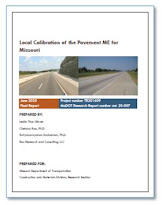The Missouri Department of Transportation (MoDOT) has a long history of concrete overlay use dating back to at least the 1930s, and over the last 20 years has constructed over 40 concrete overlay projects in a range of applications. The goal of this study was to review and evaluate the performance of bonded and unbonded overlays constructed in Missouri as a first step in documenting their performance and working to improve MoDOT’s overall concrete overlay selection, design, and construction procedures.
A database of important design, construction, and performance data for 41 selected concrete overlay projects built by the Missouri DOT from 1999 to 2019 was compiled. Three types of concrete overlays were included in this project:
1. Unbonded overlays (UBOLs): concrete overlay with thicknesses of 8 in or greater and conventional joint spacing placed on and separated from an existing concrete or asphalt pavement. A total of 26 UBOL projects were included.
2. Big block overlays (BBOLs): an unbonded concrete overlay with typical 5-in thickness and short panel size (typically 6ft by 6ft) and placed on an existing concrete or asphalt pavement. A total of 9 BBOL projects were included.
3. Bonded overlays (BOLs); a thin concrete overlay of typical 4-in thickness and 4ft by 4ft panel size bonded to the underlying asphalt or concrete pavement. A total of 6 BOL projects were included.
Time-series smoothness data were available for all projects since the time of their construction while key distress data (cracking, spalling, faulting, patching) were available from 2018. These data were examined for all overlay types and general performance trends and observations were made to identify factors leading to improved performance. Based on the findings, general recommendations to improve the performance of concrete overlays in Missouri were developed.
Report number: cmr 20-012
Published: November 2020
Project number: TR202003
Authors: Max Grogg, Arturo Espinoza-Luque, Kurt Smith, Monty Wade, and Julie Vandenbossche











